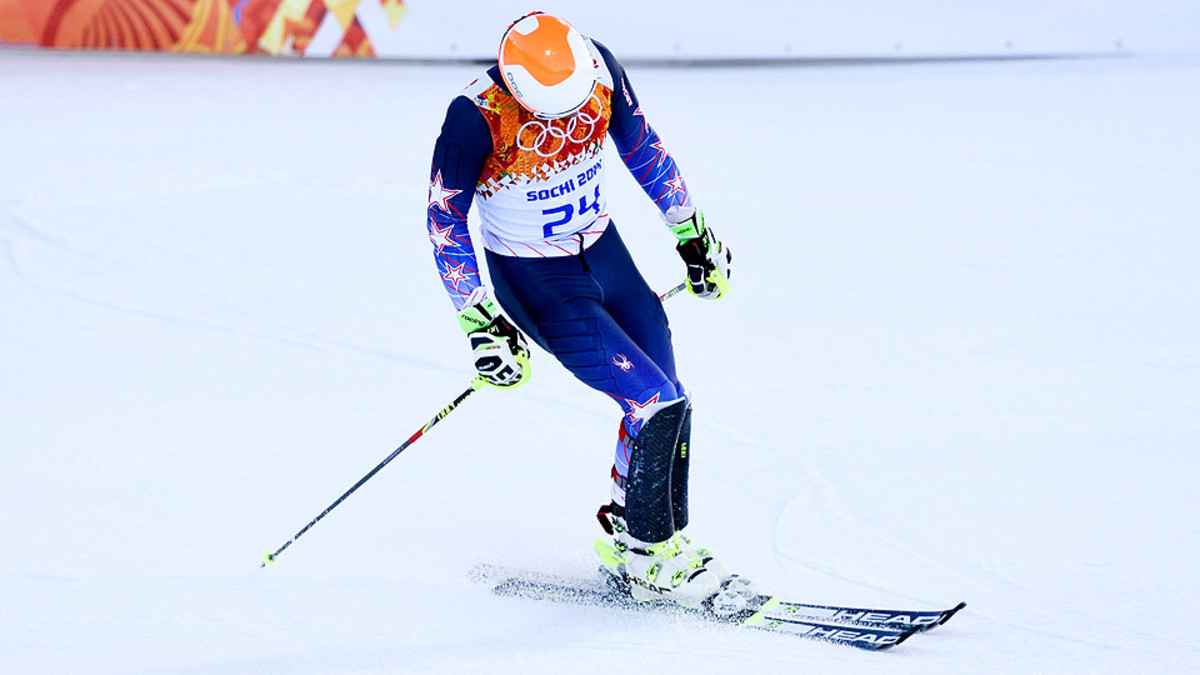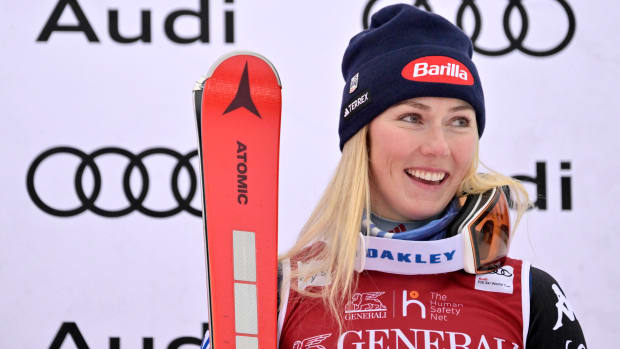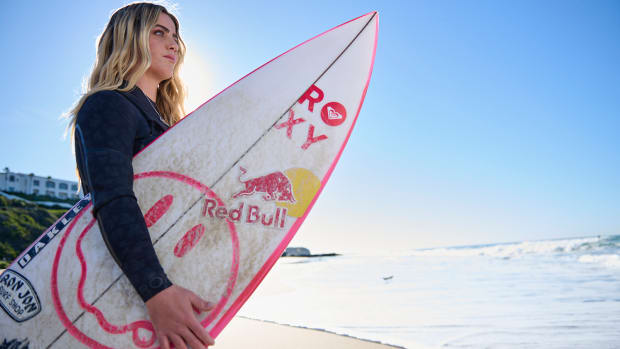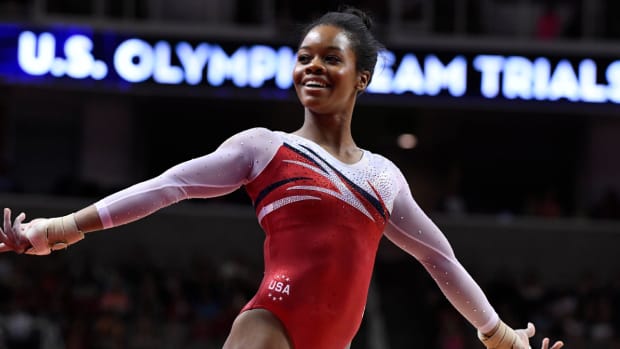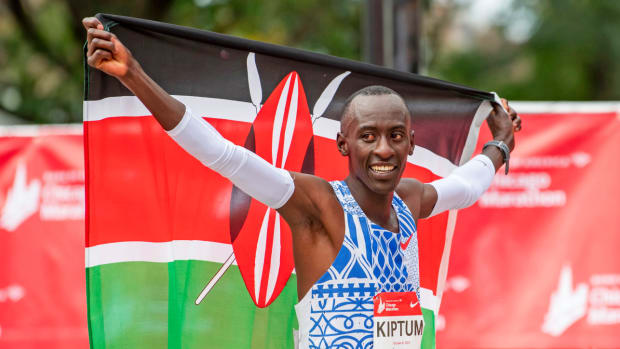Halfway through alpine skiing events, U.S. lacking momentum
KRASNAYA POLYANA, Russia -- Late Saturday morning on the rapidly melting snowpack at the Olympic Alpine Center in the Caucasus Mountains north of Sochi, Austrians Anna Fenninger and Nicole Hosp ascended a victory stand and received flowers in honor of their gold- and bronze-medal performances in the women’s Super-G event. (Their medals would be awarded later at a formal ceremony in Sochi). They cried a little and smiled a lot, and Austrian flags shimmered in the grandstand.
Five alpine ski races have been completed, five remain. It has already been a good Olympics for Austria, with four total medals and two golds, including surprise gold medalist Matthias Mayer in the men’s downhill. It has been a good Olympics for Switzerland, too, with two golds among three total medals won in alpine skiing events. There is a buzz around their skiers and a palpable sense of momentum. However, it has not, thus far, been a good Olympics for the U.S. Ski Team. There is no buzz. There is no momentum.
Check that: There is a little bit of fresh buzz, with the arrival Friday night of 18-year-old prodigy Mikaela Shiffrin, who will race the giant slalom Tuesday and the slalom three days later -- the event in which she is the reigning world champion. “Right now I think I’m the best prepared I can possibly be,” said Shiffrin in a press conference Saturday afternoon. Her teammates could use her.
Through five events, U.S. racers have won just a single medal, Julia Mancuso’s surprise bronze in the super combined last Monday. It is a poor start by any measure, but especially when viewed through the prism of Team USA’s record haul four years ago in Vancouver. Through five events in 2010, U.S. skiers had won a remarkable seven medals, including golds from Lindsey Vonn in the downhill and Bode Miller in the super combined. They would finish with a record eight medals, despite being shut out in the final four events (men’s and women’s giant slalom and slalom).
“We probably expected a little more, to be honest,” said Patrick Riml, alpine director of the U.S. Ski Team. “We’ve had a great World Cup season, some strong performances over the last couple of weeks. [But] the games aren’t over yet. We’re only halfway through.”
After finishing eighth in Saturday’s women’s Super-G, Mancuso said, “I think’s there [are] some disappointments, for sure, [but] there’s really only three skiers than can win a medal, and there’s tons of skiers out here that can step it up.”
LAYDEN: Mancuso saves her best for Olympics again, earns combined bronze
The alpine struggles are doubly painful in light of the medal domination imposed by the ski team’s United States Ski and Snowboard Association brethren in the new generation extreme sports. Through Friday night, the U.S. had won a total of 13 medals; nine of them had come in snowboard slopestyle (two, both gold), ski slopestyle (four, one gold), snowboard halfpipe (two, one gold) and moguls (one, and moguls really straddles the generational line between old and new snow sports).
There’s even a visceral reminder of this for skiers: From the alpine finish area, the extreme park lies a few thousand feet down the mountainside, its own finish stadium clearly visible. Struggles up here, medals down there.
Yet there’s a specious nature to all Olympic medal counts. The alpine team has struggled, but that struggle comes in pieces of individual success and failure. (And the Olympic ski “team” is a team in name -- and at the opening ceremony -- only; it’s a collection of individuals wearing the same uniform, offering companionship, advice and course reports in competition, but no teammate got credit for an assist on Mancuso’s bronze). Breaking down the numbers:
- Vancouver was a stunning aberration: Those eight medals won by the U.S. Ski team at the Whistler Creekside hill were just one less than U.S. racers had won the in the previous four Olympics combined. Think about that. Turin 2006: Two medals. Salt Lake City 2002: Two medals. Nagano 1998: One medal. Lillehammer 1994: Four medals, which at the time was considered sensational. Albertville 1992: Two medals.
And within that Vancouver performance were some exceptional individual efforts. Vonn rallied from a severe shin bruise to win two medals. Miller, who had self-destructed in 2006, rediscovered himself. Mancuso grew larger on a bigger stage.
Those three uber-stars accounted for seven of the medals. And Andrew Weibrecht pulled off a stunning bronze in the men’s Super-G, his first podium on the world stage (and he hasn’t had one since). It was perfect-storm stuff. It’s also an unfair comparison, like measuring every NBA team against the 1995-'96 Chicago Bulls. But when tossed that lifeline, Riml refused it.
“It’s a challenge to win eight medals,” Riml said. “It was difficult in Vancouver. Last year [at the world championships] we won five, and Lindsey Vonn was not competing.” (True, Ted Ligety won three, Mancuso and Shiffrin one each).
- Lindsey Vonn is on the Today Show, not on the ski hill: Vonn had won back-to-back World Cup overall titles leading into Vancouver, and added two more in 2010 and 2012. She struggled with illness in 2013, blew out her knee in the world championships and then blew it out again in November.
It’s impossible to know which Vonn might have arrived in Russia. There were signs that her dominance was ebbing even before her injury. But it’s fair to say that if she hadn’t been injured at all, she would have been a solid medal – if not gold -- favorite in downhill and Super-G and if she hadn’t re-injured the knee, she would have been in the hunt. We have to figure she would have won a minimum of a single medal under either circumstance. (Then again, injuries happen; Swiss Lara Gut missed the 2010 Games with a shoulder injury and Tina Weirather of Liechtenstein hasn’t skied yet in these games with a bone bruise in her right tibia. It’s a tough sport.)
Medals lost: At least one
- Miller’s mistakes: Bode Miller’s comeback at age 36 from microfracture surgery on his left knee has been remarkable, so he deserves big props for being in Sochi at all. In the 2014 World Cup season, he has at times shown flashes of his old form. He seemed poised to win the gold medal in the Sochi downhill with brilliant training runs. Instead, he made a disastrous tactical error -- “We all kind of concluded the fault came down to me,” he said -- and then mirrored that mistake in the downhill portion of the super combined.
“The mistakes I made,” he said after that downhill. “Really no excuse for that.”
Medals lost: At least one
- Ligety’s confounding combined: Ted Ligety, 29, the world’s dominant giant slalom skier, won the super combined -- a run of downhill followed by a run of slalom with the fastest cumulative time winning -- at last year’s world championships, setting him up as a potential medalist in Sochi. He is a serviceable downhill skier and at times a dynamic slalom racer. Even after he skied only passably in the downhill portion of Friday’s combined and stood 1.93 seconds out of the lead, other racers saw him as one of the racers to beat for a medal. Yet after watching a succession of racers beaten up and tossed off Croatian coach Ante Kostelic’s tricky slalom course (including slalom racer extraordinaire Alexis Pinturault of France), Ligety got risk-averse.
“I respected the course too much,” he said. “I skied definitely way too conservative, and that’s really frustrating. I didn’t think it would take a run that was 100 percent to get a medal.” He finished 12th, behind Miller (sixth) and Jared Goldberg (11th).
Medals lost: One
LAYDEN: Ligety, Miller flounder in super combined, adding to U.S. alpine skiing woes
- Mancuso’s malaise: Have to be fair here: Mancuso’s bronze medal in the women’s super combined on the first Monday of the Games was an epic moment, a superb downhill on the Squaw Valley soft snow she loves and then a slalom run pulled from deep in her past. On Saturday she called it “magical,” and that is no exaggeration. Shiffrin made a point of praising it.
“Congratulations to Julia,” said Shiffrin. “She knows how to ski downhill and he knows how to ski slalom, too, but she skied slalom for so long and I think the sport has change.” It gave Mancuso four Olympic medals, double that of any U.S. female alpine racer in history, including Vonn and Picabo Street, who have two each.
That medal also had another effect: It took Mancuso’s edge. She won the combined downhill, but finished only eighth in both the downhill and the Super-G. She called her races “conservative,” and said after the Super-G on Saturday, “I left the starting gate wanting to ski well, not necessarily wanting to win. For sure, in my mind I wanted to win, but I felt like with my skiing and after I got down to the bottom of the hill, it was definitely conservative.”
Medals lost: No more than one
- Rough conditions: You’ve probably heard that it’s warm in Sochi -- sunbathers on the Black Sea and all that. The alpine center is 5,000 feet above sea level (and craggy peaks tower far above that). But it has been warm. Temperatures during the break in Friday’s men’s super combined soared into the mid 50s. The heat transforms the hard, icy surface that most skiers prefer (though not necessarily Mancuso) into softer snow that more closely resembles what you might find in someone’s back yard in March. Such conditions can throw form into disarray. (After the downhill, Miller called the hard, cold conditions in which official training were contested, “The perfect conditions to see who is the best racer.” It’s a statement that verges on excuse-making, but isn’t entirely untrue).
Riml would have none of this angle: “That’s not an excuse,” he said. “The conditions… it’s very unusual. There’s no doubt about that. But it’s the same for everybody.”
Medals lost: Who knows?
Ski racing is notoriously fickle, an outdoor sport contested on a slippery surface and decided by hundredths of a second. (Here in Sochi, there was an unprecedented goal-medal tie in the women’s downhill.) Miller is right, the best ski racer doesn’t always win, but some ski racer always medals. Sometimes it is Andrew Weibrecht, against all odds.
'There is a saving grace in all of this analysis for the U.S. It’s only halftime. In Vancouver, after winning those eight medals in the six speed and combined events, the U.S. was shut out in the so-called “technical” events of giant slalom and slalom. In Sunday’s Super-G, Ligety is the defending world champion and Miller remains a threat. Travis Ganong, who finished fifth in the downhill, appears on the verge of his first podium. The giant slalom owes Ligety a medal; he has dominated that event on the world cup for the last seven seasons.
And there is Shiffrin. A year ago she won not only the world championship in slalom, but also the World Cup season slalom title. This year she has added two giant slalom podiums, throwing herself into the mix in that event. She conducted a 20-minute press conference on Saturday with uncommon poise. At one point she explained to the gathered media that she had long anticipated most of the questions she was being asked and said, “I wrote answers down in my notebook, the things I want to say.” This preparation, she said, also applies to visualizing her races, everything from winning to falling.
Shiffrin said she has been training in Italy, German and Austria, where heavy, wet snow has simulated the conditions she will face in Sochi. “On race day, I don’t plan to have that as an excuse,” said Shiffrin. “If I don’t win, it’s because of something to do with my skiing. If I do win, it’s because of my skiing.”
And this, of what she’s seen so far of these Games: “It’s a learning lesson,” Shiffrin said. “No matter how good you are, you can’t take you foot off the gas.”
Medals gained: At least one
